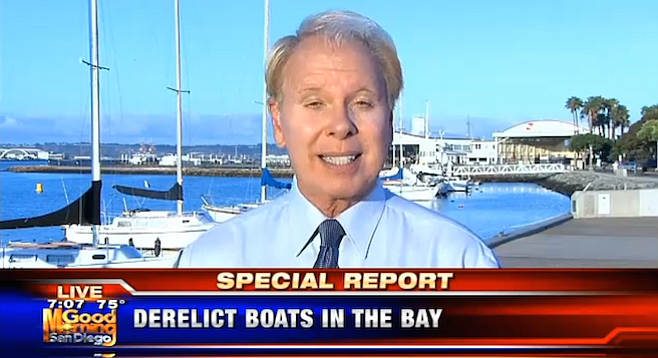 Facebook
Facebook
 X
X
 Instagram
Instagram
 TikTok
TikTok
 Youtube
Youtube

A slanted bit of journalism by Ed Lenderman was aired on KUSI the second week of September, concerning supposedly derelict boats in San Diego Bay.
The report opens dramatically, recalling the costly cleanup of the former free and ungoverned A-8 anchorage in South Bay. He makes a comparison with the port-run mooring system, which has functioned well for the past 20 years.
KUSI report
Some of the vessels likely on the port’s list of boats of concern are being addressed via due process, but for the most part, KUSI showed footage of the same boats over and over, mostly shots of waterlines with algae accumulations and/or peeling paint, which, while unsightly, are not indications of a vessel’s lack of seaworthiness.
The port and the mooring company are strict about the required annual inspections, or surveys. Owners of vessels that have issues are given time to rectify them and are ousted if they do not. Also, contrary to what Lenderman stated, few, if any, marinas require their vessels to undergo annual inspections, unlike the moored boats.
Lenderman would have supported his points if he could have shown some boats on the verge of sinking, but he did not because there are none.
It is clear that he knows little of boats and had no idea what he was looking at and having filmed. He criticized boats lacking sails, unaware that, when a sailboat is not being used for long periods of time, it is prudent to stow the sails below where they are not at the mercy of the elements.
He showed one boat as an example, which had large, ugly, brown patches. What he showed was actually a well-done repair, nicely faired out and lacking only the final coat of paint. Epoxy and filler make a brown patch that is not pretty, but it is an indication of a boat that's being maintained.
One boat, loaded with what appeared to be junk on the deck, was actually undergoing a repair procedure below that required the temporary relocation of a large amount of stuff. The only place for it was on the deck while this was being done. Unfortunately, Lenderman and his crew came along during this time and filmed it as an example.
The moored boats are also subject to much more wear-and-tear than boats that stay in sheltered slips in marinas. Most of the people living on moored boats are not in the upper income brackets. To infer that only rich people should own boats is un-American.
After blindsiding one boater with his confrontation, Lenderman and the anchorwoman rudely mocked the boater’s response, giving the impression that he had gone into this investigation with the preconceived notion that anyone owning these boats must be a scumbag to begin with.
The letter writer lives part-time on a boat moored in America's Cup Harbor (formerly the Commercial Basin). Her boat was not pictured in the KUSI report.


A slanted bit of journalism by Ed Lenderman was aired on KUSI the second week of September, concerning supposedly derelict boats in San Diego Bay.
The report opens dramatically, recalling the costly cleanup of the former free and ungoverned A-8 anchorage in South Bay. He makes a comparison with the port-run mooring system, which has functioned well for the past 20 years.
KUSI report
Some of the vessels likely on the port’s list of boats of concern are being addressed via due process, but for the most part, KUSI showed footage of the same boats over and over, mostly shots of waterlines with algae accumulations and/or peeling paint, which, while unsightly, are not indications of a vessel’s lack of seaworthiness.
The port and the mooring company are strict about the required annual inspections, or surveys. Owners of vessels that have issues are given time to rectify them and are ousted if they do not. Also, contrary to what Lenderman stated, few, if any, marinas require their vessels to undergo annual inspections, unlike the moored boats.
Lenderman would have supported his points if he could have shown some boats on the verge of sinking, but he did not because there are none.
It is clear that he knows little of boats and had no idea what he was looking at and having filmed. He criticized boats lacking sails, unaware that, when a sailboat is not being used for long periods of time, it is prudent to stow the sails below where they are not at the mercy of the elements.
He showed one boat as an example, which had large, ugly, brown patches. What he showed was actually a well-done repair, nicely faired out and lacking only the final coat of paint. Epoxy and filler make a brown patch that is not pretty, but it is an indication of a boat that's being maintained.
One boat, loaded with what appeared to be junk on the deck, was actually undergoing a repair procedure below that required the temporary relocation of a large amount of stuff. The only place for it was on the deck while this was being done. Unfortunately, Lenderman and his crew came along during this time and filmed it as an example.
The moored boats are also subject to much more wear-and-tear than boats that stay in sheltered slips in marinas. Most of the people living on moored boats are not in the upper income brackets. To infer that only rich people should own boats is un-American.
After blindsiding one boater with his confrontation, Lenderman and the anchorwoman rudely mocked the boater’s response, giving the impression that he had gone into this investigation with the preconceived notion that anyone owning these boats must be a scumbag to begin with.
The letter writer lives part-time on a boat moored in America's Cup Harbor (formerly the Commercial Basin). Her boat was not pictured in the KUSI report.
Comments